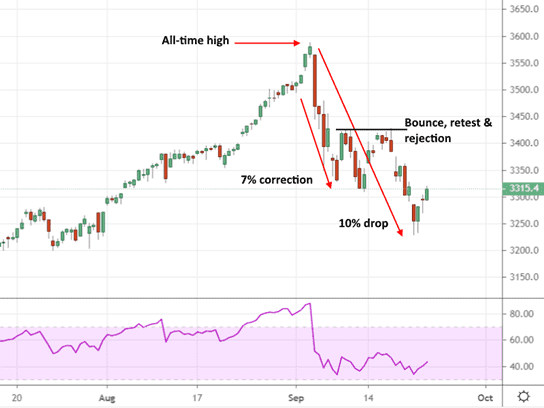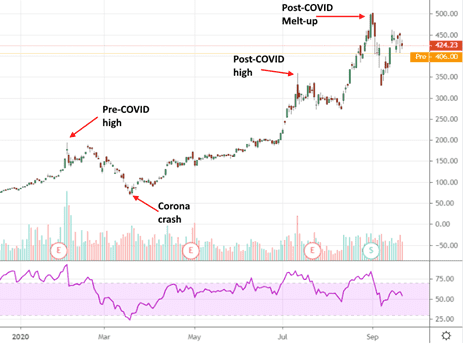When things are bad, it often feels like the end of the world; when they’re good, it seems like the fun will never end.
There’s an old saying, “make hay while the sun shines,” which means you should take advantage of all your opportunities while they last. The adage is particularly relevant to our financial markets of late, as investors seem to have taken it literally over the summer. Even as markets around the world have tumbled following the spread of the coronavirus around the world, it’s getting harder to resist the urge to find the right dip to buy. At the time, with flu season on its way (at least in the Northern Hemisphere), we witnessed a strong recovery as well as increased confidence that the worst was behind us, that a vaccine was just around the corner, and that a full return to growth was on the cards for 2021.
Of course, collective sentiment tends to outweigh both the upside and the downside. When things are bad, it often feels like the end of the world; when they’re good, it seems like the fun will never end. What we now face is a moment of collective sobering up. Winter is coming, the number of cases of COVID-19 is on the rise again, it seems that further lockdowns are on the way, and investors do not want to be caught on the wrong foot like in March.
Market Sell-Off
After the fall in US stocks seen in early September from their all-time highs, the S&P 500 tried to bounce back, stalling at 3422 between September 8 and 10, unsuccessfully retesting the same level between September 15 and 16, and it has since set a new low at around 3230. We’ve seen the Dow Jones Industrial Average and Nasdaq do much the same thing, with the S&P 500 and Nasdaq recently reaching levels last seen in July and the Dow Jones since early August. On Monday, September 21, for the first time since February, the S&P 500 recorded losses for four consecutive days. It ended up about 10% from the index’s record high set on September 2.

As usual, every bounce is met with a great deal of fanfare. The S&P 500 is currently up about 2.9% from those lows, but further selling could occur. The pushback we’re seeing is currently being led by tech giants Amazon and Apple. Other common players in the tech space (Microsoft, Alphabet, and Facebook) combined to fuel the US stock market’s incredible post-Covid-19 rally and also saw a slight gain from the selloff.
Market Worries
What we are seeing now is a period of coming back to earth and a tentative recognition that stocks may have strengthened too much over the summer to become overvalued relative to the risks. The first of the unknowns weighing on the animal spirits of investors is whether Congress will approve further stimulus measures before the November elections. This was echoed by Fed President Jerome Powell, who publicly called for further fiscal support from the government. With unemployment benefits and other CARES Act stimulus measures recently expiring, the big question on everyone’s lips is whether deadlocked Washington will be able to pull together another package.
Tensions between the US and China also continue to rise with President Trump taking shots at Chinese technology platforms. Citing data privacy and national security concerns, the US Department of Commerce recently launched a series of measures that will severely restrict the US activities of Chinese technology companies such as TikTok and WeChat.
Meanwhile, the recent death of Supreme Court Justice Ruth Bader Ginsberg has further heightened tensions in an already tense race as Republicans and Democrats begin a bitter battle over who will replace her.
All of the above is happening amid an increase in the number of corona virus cases. Apart from the United States, the list of the top 15 daily cases of coronavirus all summer was dominated by the developing world (mainly South America, India and Russia). We’ve recently seen Spain and France re-emerge with an explosion in daily cases, and now the UK is back on the list. On Sunday, September 20, the UK reported 4,422 cases, the highest number of cases since May. With new cases and hospital admissions doubling every week, it is now becoming apparent to leaders in the northern hemisphere that a second wave is almost upon us, that easing measures over the summer and encouraging the public to go out and spend has given the virus a foothold just when flu season is starting.
Tesla in the spotlight
The stocks that perform the hardest during the irrational exuberance of a rally may be the ones that sell off the hardest when the outlook starts to change. Before Covid, Tesla peaked in February at around $193 per share. Post-Covid it rose to around $360 in July and then catapulted to $500 in late August to the complete bewilderment of most observers.

Tesla’s stock was particularly hard hit during this recent selloff. On September 8, it fell lower at the open and went from $417 on Friday to around $330 at Tuesday’s closee. That’s a drop of more than 21%, the worst one-day performance in the company’s history, wiping more than $80 billion from the company’s valuation. From peak to trough, Tesla corrected over 34% in September. Truth be told, the bounce was even more impressive, rebounding more than 38% from its September 8 low and setting a lower high around $463.
Besides the technicalities, what else burdens Tesla’s favorite story? Well, for one thing, the company was widely expected to be added to the S&P 500. That didn’t happen because the committee responsible for vetting new entries decided against the addition. Recently, the company’s CEO, Elon Musk, stated that the company may have difficulty ramping up production after analysts warned that its heavy reliance on aluminum parts could pose problems. Finally, while the stock behaves and is often treated like a kind of honorary tech stock, the reality is that it’s an automaker that could be hit hard by a second wave of coronavirus infections and lockdowns. This is due to supply chain disruptions, but also a change in priorities among consumers should the global economy take another hit. Tesla is definitely a stock to watch because the potential downside is big if the worst happens, as well as the inevitable spikes after each sale.
Trade with HYCM
About HYCM
HYCM is the global brand name of Henyep Capital Markets (UK) Limited, HYCM (Europe) Ltd, Henyep Capital Markets (DIFC) Ltd and HYCM Ltd, all individual entities under the Henyep Capital Markets Group, a global corporation established in 1977, operating in Asia , Europe and the Middle East.
Warning about high-risk investments: Contracts for Difference (“CFDs”) are complex financial products that are traded on margin. Trading CFDs carries a high degree of risk. It is possible to lose all your capital. These products may not be suitable for everyone and you should make sure you understand the risks involved. Seek independent professional advice if necessary and only speculate with funds you can afford to lose. Carefully consider whether such trading is suitable for you, taking into account all relevant circumstances as well as your personal resources. We do not recommend that customers post their entire account balance to meet margin requirements. Clients can minimize their level of exposure by requesting a leverage limit change. See HYCM’s Risk Disclosure for more information.
References:
https://www.theguardian.com/business/2020/sep/21/us-stock-markets-fall-dow-drops-510-points-coronavirus-fears
https://uk.reuters.com/article/usa-stocks/us-stocks-nasdaq-sp-500-crawl-higher-on-amazon-apple-boost-idUSL3N2GJ2HV
https://www.voanews.com/economy-business/us-stocks-fall-global-markets-swoon
https://www.barrons.com/articles/global-stocks-slump-on-worries-over-infections-gridlock-and-money-laundering-allegations-51600680149
https://www.straitstimes.com/business/companies-markets/us-stocks-advance-cautiously-after-powell-mnuchin-testify
https://www.worldometers.info/coronavirus/
https://www.bbc.com/news/business-54234006
https://www.cnbc.com/2020/09/08/tesla-shares-slump-10percent-in-premarket-trading-after-sp-500-snub.html
